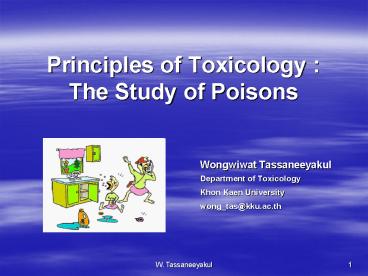Principles of Toxicology : The Study of Poisons - PowerPoint PPT Presentation
1 / 48
Title:
Principles of Toxicology : The Study of Poisons
Description:
Fixed drug eruption Drug rash SJS A villager uses a dip net to remove dead fish from the Bang Pakong river. The fish, bred in floating baskets, ... – PowerPoint PPT presentation
Number of Views:397
Avg rating:3.0/5.0
Title: Principles of Toxicology : The Study of Poisons
1
Principles of Toxicology The Study of Poisons
- Wongwiwat Tassaneeyakul
- Department of Toxicology
- Khon Kaen University
- wong_tas_at_kku.ac.th
2
Objective of Learning
- To know scope and definition of toxicology,
- Describe how toxicologist work and manage
toxicants, - Understand dose-response relationship and
interactions
3
Lake Nyos
August 21st, 1986, 930 pm
gt1700 people and 3000 dead cow!!!
4
Asia's arsenic crisis deepens Another Indian
state succumbs to well water poisoning. 15
February 2003 TOM CLARKE
Hand-pump wells tap into natural accumulations of
arsenic.
5
Thalidomide tragedy
6
Fixed drug eruption
Drug rash
SJS
7
A villager uses a dip net to remove dead fish
from the Bang Pakong river. The fish, bred in
floating baskets, died from pollution in the
river. _ TAWATCHAI KEMGUMNERD Friday 15
November 2002 BangkokPost
8
?????? 2547 ?????????????????
?????????????????????????????????????
9
Intoxication
Toxicity
Hazard
Poisoning
10
Definitions
- TOXICOLOGY The study of the adverse effects of
a toxicant on living organisms.
Toxicology related closely to Pharmacology,
Biochemistry, Molecular biology, Chemistry,
Epidemiology, Pathology, Genetics, Public Health,
Medicine, etc.
11
Definitions
- Hazard physical situation that can damage
- people
- plant
- Environment
- Risk likelihood of hazard occurring
- Risk hazard probability consequence
12
Source Muckter, 2003
13
3 Basic component in toxicology study
- Toxicant/ Toxin/ Poison/ Hazard
- any agent capable of producing a deleterious
response in a biological system - Adverse/Toxic effects
- any unwanted change from an organisms normal
state - dependent upon the concentration of active
compound at the target site (receptor)for a
sufficient time. - Living organism
- cellular target sites/ storage depots and enzymes
14
COMMON TOXICOLOGY QUESTIONS
- What is a poison?
- Where dose it come from? (exposure Q)
- How does it get into living organism? (exposure
Q) - What does it do to living organism? (mechanism Q)
- How can we treat/prevent this toxicity? (clinical
Q)
15
Routes of Entry
- Oral Ingestion by mouth
- Dermal Skin exposure
- Inhalation Absorbed by lungs
- Ocular Eye exposure
16
Bioaccumulation
Why human have to concern with other species
toxicology and/or environmental health?
17
Classification of Toxic Agents
- Target organ/site (e.g., liver, kidney, blood,
lung, nerves) - Use (e.g., pesticide, solvent, food additive)
- Effects (e.g., cancer, mutation, liver injury)
- Labeling requirements (e.g., explosive,
flammable, oxidizer) - Poisoning potential (e.g., very or slightly toxic)
18
Dose-Response Relationship
Allein die Dosis macht, daß ein Ding kein Gift
ist. (Dose determines toxicity)
19
THE DOSE MAKES THE POISON
- All substances are poisons there is none that is
not a poison. The right dose differentiates a
poison and a remedy. - Paracelsus
- (1493- 1541)
20
DOSE
21
What is a Response?
- Change from normal state
- could be on the molecular, cellular, organ, or
organism level--the symptoms - Graded vs. Quantal
- degrees of the same damage vs. all or none
22
Dose-response
EFFECT
non-linear, threshold
linear, no threshold
Dose
23
(No Transcript)
24
(No Transcript)
25
(No Transcript)
26
LD50 Comparison
27
Toxicity rating
28
THE DOSE-RESPONSE RELATIONSHIP
The dose-response relationship (from C.D.
Klaassen, Casarett and Doulls Toxicology, 5th
ed., New York McGraw-Hill, 1996).
29
(No Transcript)
30
(No Transcript)
31
Type of Toxic Response
- Acute vs. Chronic
- Allergic (hypersensitivity)
- Idiosyncratic (e.g. G6PD def.)
- Local vs. Systemic
- Reversible vs. Irreversible
32
Acute Toxicity
- (short-term exposure)
33
Chronic Toxicity
- (repeated exposures)
34
Examples Chronic Effects
- Carcinogens
- Cause cancer
- Mutagens
- Cause mutations in an organisms genetic material
- Teratogens
- cause birth defects in offspring following
exposure of a pregnant female
35
(No Transcript)
36
Drug rash
37
Dose-response relationship LEAD
decreased erythrocyte delta-ALAD
activity increased zinc protoporphyrin
anemia
CNS effects
decreased peripheral nerve conductivity Nervous
paralysis, lead colics
Adapted from Elinder C-G et al., Biologisk
monitoring av metaller hos människa.
Arbetsmiljöfonden, Uppsala, 1991
38
Toxicity Interactions
- Additive 22 4
- Synergism 23 10
- Potentiation 03 5
- Antagonism 2(-2) 0
- Chemical antagonism
- Dispositional antagonism
- Functional antagonism
- Pharmacological antagonism
39
(No Transcript)
40
Synergist / Synergism
Synergism is increased activity (toxicity)
resulting from the effect of one chemical on
another.
LD50 DDT 250 mg/kg LD50 synergist 1,000
mg/kg LD50 DDT synergist 50 mg/kg
41
Source van den Brandt et al. 2002
42
Epidemiology study
43
Epidemiology study
44
(No Transcript)
45
Source A Primer on Toxics
46
(No Transcript)
47
Conclusion
- What is toxicology ?
- Toxicity, poison, hazard, risk ?
- Why dose-response study is so important in
toxicology? - How can we classify type of toxicity ?
- Why people response differently to toxicant ?
48
THE DOSE MAKES THE POISON
- ?????????????????????????
- ??????????????????????????
- ??????????????????????????????
- ???????????????????????????
- ??????????? ?????????

